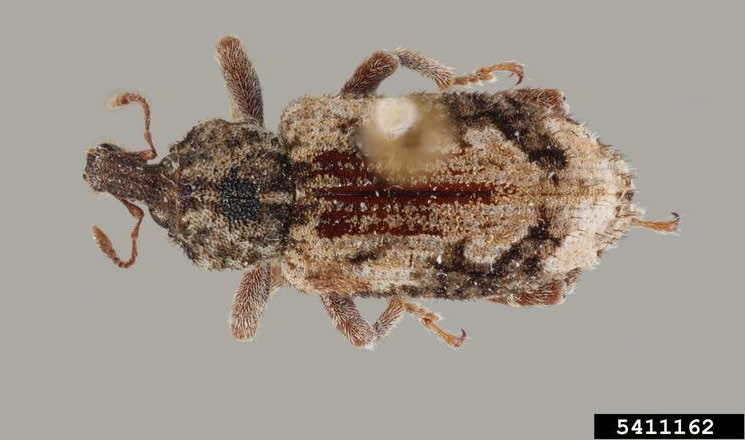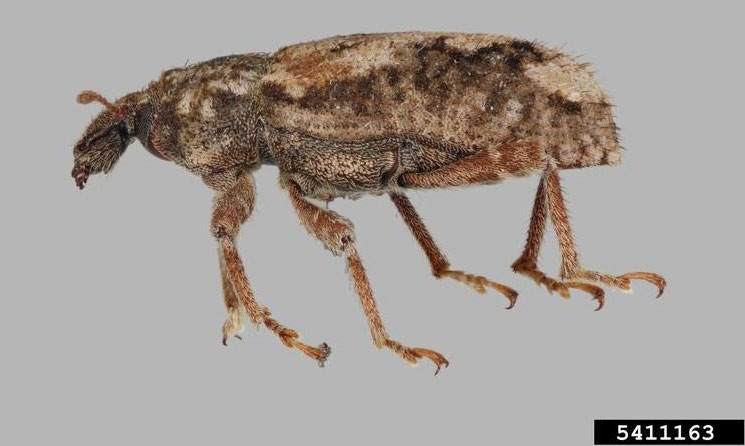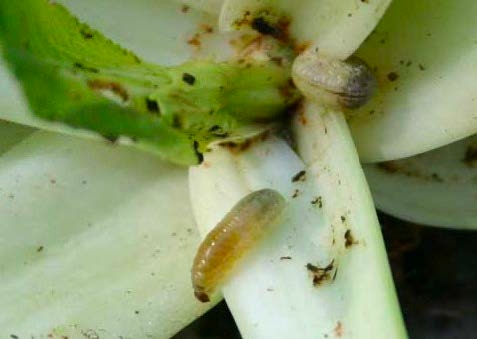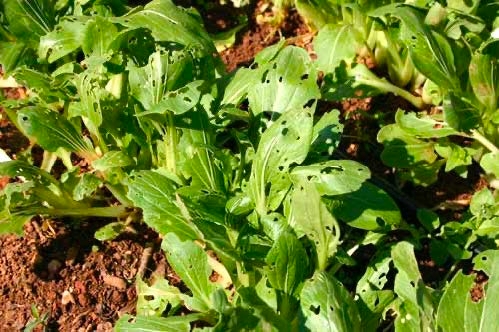Vegetable Weevil
ID
3104-1569 (ENTO-425NP)
Introduction
Vegetable weevil, Listroderes difficilis Germain, is often misidentified as the very similar appearing L. costirostris Schönherr. These weevils belong to the family Curculionidae in the order Coleoptera. Vegetable weevil is native to South America, but is now found in the southern United States, California, Oklahoma, and Arizona. The sister species Listroderes costirostris is not known to occur outside of California and western Arizona.
Description
Adult vegetable weevils are a dull, gray-brown color measuring about 6-8 mm (about 0.25-0.3 inch) long (Figs. 1 and 2). Adults are somewhat bristly in appearance due to stout hairs and dense scales on the body. Frequently they have a set of dark diagonal markings framing a lighter colored V-shape on the wings, but these markings may wear off with age. Antennae are elbowed and there is a short, stout snout at the front of the head.

Newly-hatched larvae are slender, pale C-shaped grubs with a dark head capsule. They turn greenish as they feed and mature (Fig. 3). Mature larvae measure about 14 mm (0.6 inch) long.


Common Host Plants
Vegetable weevils are polyphagous, attacking a wide host range including many cole crops (turnip, collard, mustard, and others); tomato, potato; carrot, beet, radish, turnip, beans; tobacco; many weeds and some ornamentals.
Damage
Both larvae and adults feed on the foliage, buds, and roots of host plants. Larvae may graze the outer surface of fleshy roots before boring into the root. Larvae also feed on crowns and lower stems of host plants (Fig. 3). Larval feeding on foliage initially begins as small round holes, which are then enlarged to a more irregular shape (Fig. 4). Continued feeding may leave the foliage skeletonized. Adults feeding on stems close to the ground may girdle or cut through the stem entirely. Damage by vegetable weevil is often most severe on young plants. However, vegetable weevil is not considered as important of a pest species as it once was. Chemical treatments for other pests appear to have reduced the impact of vegetable weevil.

Life History
Female vegetable weevils are parthenogenetic and males are not known for this species. Eggs are laid on the plant crown or otherwise near the soil line beginning in late summer and sometimes into early spring. Egg and larval development occur gradually over several months. Mature larvae enter the soil to pupate over the winter and adults emerge the following spring. There is a single generation per year and adult weevils may live 1-2 years. Adults and grubs are more active at night, retreating to the soil or under leaf litter during the day. Adults aestivate during the summer months in plant debris near field edges. Because adults rarely fly, they are usually found in spots near the edges of fields rather than throughout the entire field. Like many weevils, adult vegetable weevils feign death when disturbed, often dropping off the host plant.
Cultural Control
Adults aestivate in the summer in garden residue; removing crop debris may reduce their survival during the hot months. Weed control around plots or fields may reduce alternate hosts and refuges for vegetable weevil. If vegetable weevil is a known concern in a field, rotate susceptible crops with less favored crops and avoid planting susceptible crops nearby. Soil cultivation and tillage after harvest will destroy pupae in the soil before adults emerge in the spring.
Organic/Biological Control
Neem oil and pyrethrins are options for organic control. Insecticidal soaps can be used against larvae in home gardens. Certified organic growers should always check that an organic method is approved by their certifier. No commercial biological control agents are available for vegetable weevil at this time, although a range of generalist predators may feed on the larvae opportunistically.
Chemical Control
Adult vegetable weevils rarely fly and may be found in clumped aggregations around field borders. Spot treat foliage for vegetable weevil where found with a registered insecticide. Chemical controls for other defoliating pests generally limit damage from vegetable weevil as well.
Virginia Cooperative Extension materials are available for public use, reprint, or citation without further permission, provided the use includes credit to the author and to Virginia Cooperative Extension, Virginia Tech, and Virginia State University.
Virginia Cooperative Extension is a partnership of Virginia Tech, Virginia State University, the U.S. Department of Agriculture (USDA), and local governments, and is an equal opportunity employer. For the full non-discrimination statement, please visit ext.vt.edu/accessibility.
Publication Date
March 4, 2021



